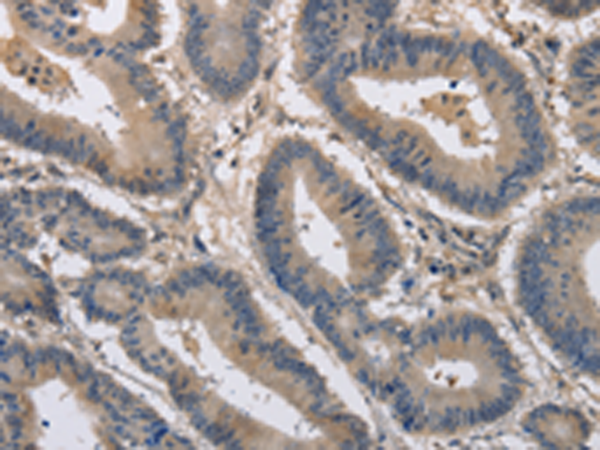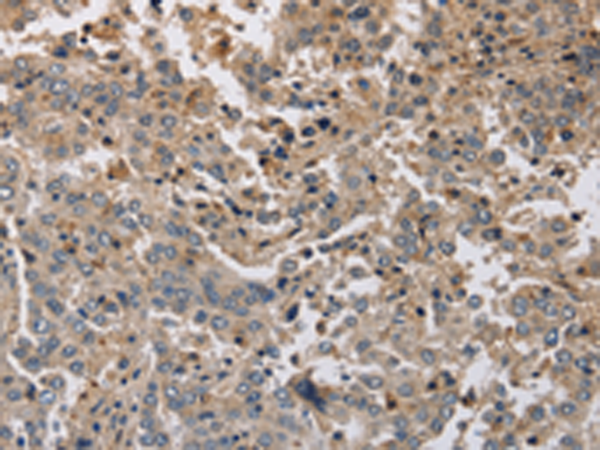


| WB | 咨询技术 | Human,Mouse,Rat |
| IF | 咨询技术 | Human,Mouse,Rat |
| IHC | 1/25-1/100 | Human,Mouse,Rat |
| ICC | 技术咨询 | Human,Mouse,Rat |
| FCM | 咨询技术 | Human,Mouse,Rat |
| Elisa | 1/1000-1/2000 | Human,Mouse,Rat |
| Aliases | KV4.1 |
| WB Predicted band size | 71 kDa |
| Host/Isotype | Rabbit IgG |
| Antibody Type | Primary antibody |
| Storage | Store at 4°C short term. Aliquot and store at -20°C long term. Avoid freeze/thaw cycles. |
| Species Reactivity | Human |
| Immunogen | Synthetic peptide of human KCND1 |
| Formulation | Purified antibody in PBS with 0.05% sodium azide and 50% glycerol. |
+ +
以下是关于KCND1抗体的3篇参考文献的简要信息,供参考:
---
1. **文献名称**:*Kv4.1 potassium channel modulates cerebral artery smooth muscle cell proliferation during hypertension*
**作者**:Li H, et al.
**摘要**:研究利用KCND1抗体(抗Kv4.1)通过Western blot和免疫荧光技术,发现高血压模型中脑血管平滑肌细胞Kv4.1通道表达下调,提示其与细胞增殖异常相关。
---
2. **文献名称**:*Localization of Kv4.1 channels in the murine auditory brainstem by immunohistochemistry*
**作者**:Barnett EM, et al.
**摘要**:通过KCND1特异性抗体进行免疫组化分析,揭示Kv4.1通道在小鼠听觉脑干神经元中的分布模式,支持其在动作电位复极化中的功能。
---
3. **文献名称**:*Altered expression of potassium channel gene KCND1 in temporal lobe epilepsy*
**作者**:Huang X, et al.
**摘要**:使用KCND1抗体检测癫痫患者脑组织中Kv4.1蛋白表达,发现颞叶皮层表达显著降低,可能参与癫痫相关的离子通道病理机制。
---
如需具体文献链接或更多细节,可进一步提供PMID或DOI编号。
The KCND1 antibody targets the potassium voltage-gated channel subfamily D member 1 (KCND1), which encodes the Kv4.1 protein, a key component of voltage-gated A-type potassium channels. These channels are critical for regulating action potential repolarization and excitability in excitable cells, particularly in the heart and brain. Kv4.1 channels contribute to transient outward potassium currents (Ito) in cardiac myocytes, influencing early phase repolarization, and modulate A-type currents in neurons, affecting synaptic plasticity and firing patterns. Dysregulation of KCND1 expression or function has been linked to cardiac arrhythmias, such as Brugada syndrome, and neurological disorders.
KCND1 antibodies are essential tools for studying the distribution, expression levels, and functional roles of Kv4.1 in tissues and disease models. They are commonly used in techniques like Western blotting, immunohistochemistry, and immunofluorescence to validate protein presence, localization, and alterations under pathological conditions. Researchers also employ these antibodies to investigate channel trafficking, post-translational modifications, and interactions with regulatory subunits like KChIPs. Specificity is typically confirmed using knockout controls or siRNA-mediated knockdown. Commercial KCND1 antibodies are often raised against conserved epitopes, enabling cross-reactivity in multiple species, including humans, mice, and rats. However, variability in antibody performance across applications necessitates careful validation. Understanding KCND1's role through these antibodies aids in unraveling its contributions to cellular excitability and disease mechanisms.
×